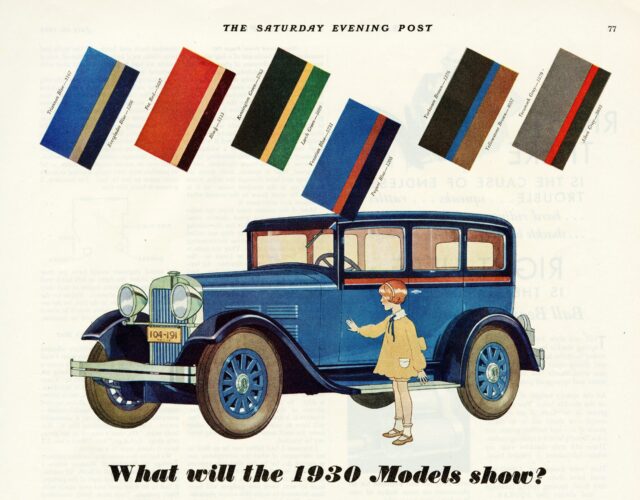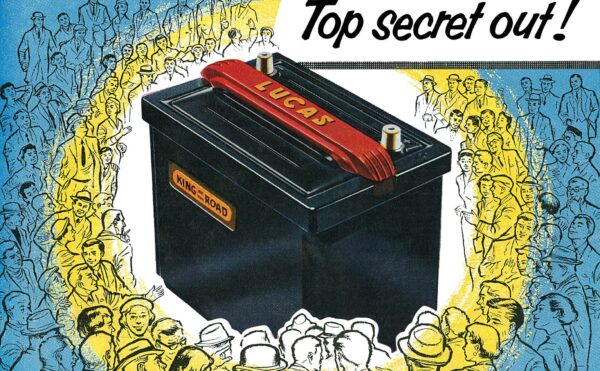Regina Lee Blaszczyk. The Color Revolution. Cambridge, MA: MIT Press, 2012. 368 pp. $34.95.
We live in a colorful world, but where does all that color come from? Who determines the colors of our clothes, automobiles, and other consumer goods? In the fascinating and beautifully illustrated Color Revolution, Regina Blaszczyk tells the unheralded story of the industrial colorist, a profession that developed alongside industrial design in the decades after World War I. These new professions brought art into industry, similar to the ways industrial research was bringing science into industry. American artists hoped that by designing tasteful and attractive goods they could promote cultural uplift and civility to a nation that seemingly had been overwhelmed with unsophisticated immigrants from largely rural regions of southern and eastern Europe. Color and good design would help Americanize these newcomers.
For manufacturers industrial design meant creating goods that were compatible with the new methods of mass production pioneered by Henry Ford in the early 1910s. Mass production required mass merchandising. Exactly what shapes and colors of goods would be attractive to the hypothetical “masses”? Answering this difficult question provided entrepreneurial opportunities for those who could do market research, keep current on fashions in Paris, familiarize themselves with modern art, and understand the psyche of the American consumer.
Industrial designers became responsible for annual model changes beginning in the 1920s at General Motors, but their contributions increased in importance during the Great Depression. Changing the color of goods became an essential part of this redesign process. What better way to get consumers to repaint their houses or buy new cars or radios than to offer them newer, more fashionable, and in the buzzword of advertisers more “modern” goods. Although the heart of the color revolution lies in these interwar years, Blaszczyk takes us back to the invention of synthetic dyestuffs and forward to the competitive and individualistic fashion world of the 1960s.
William Henry Perkin’s 1856 discovery of a purple dye, named mauve by the textile industry, launched a chemical-research enterprise that within a few decades created synthetic organic dyes in a rainbow of colors. The incorporation of color into industrial processes was not easy. An unlimited color palette overwhelmed manufacturers; the trade press worried that “colors had run riot” (p. 78).
In the mid-19th century Michel-Eugène Chevreul had brought order to color by categorizing the 14,000 colors used in the wool industry into 72 kinds of shade, 10 degrees of purity, and 21 degrees of intensity. Later in the United States, in 1915, a new trade association attempted to rationalize color in American industry by determining “a limited line of best shades rather than a large line of good shades” (p. 79), noting that in the United States little more than 100 shades accounted for 75% of color consumption. Another vexing problem was standardization. Mass-produced goods had to exhibit color consistency. With the development of fashion ensembles colors had to match across producers: shoes had to match handbags, and so on. Many schemes of color standardization were established, but science never completely replaced the skilled artistic eye.
Atop technical concerns were purely human ones: what colors were most appropriate for clothes and other consumer goods? Arbiters of fashion and good taste had definite ideas about what was appropriate (usually muted colors) versus what many segments of society wanted (bright colors). As Blaszczyk states, “In 1930 the editors of Fortune declared that the ‘Anglo-Saxon’ had been released from his ‘chromatic inhibitions’ and was now ready to ‘outdo the barbarians’ in the use of brilliant hues” (p. 1).
The biggest challenge facing manufacturers was predicting what colors would be fashionable six months or a year in the future, when the goods they were designing would appear in stores. In the 1920s and 1930s many companies, including General Motors and DuPont, looked to Paris fashion houses as the authorities on color. What was chic in Paris haute couture would appear later as ready-to-wear clothes in American department stores and in the upholstery of car interiors. Industry sought the advice of color consultants who kept track of what was happening in France and interpreted it for the American market.
During World War II, with Paris out of the picture, the center of fashion shifted to New York. After the war New York and Paris competed and cooperated. Paris still led in fashion, but the mass market was in America. In New York, fashion became a competitive tool associated with brand names and extensive advertising. Before World War II, experts dictated what colors were fashionable; in the postwar world consumers were increasingly urged to choose their own style from the variety of choices at hand. A century after Perkin’s breakthrough the color revolution was largely over. Color was no longer viewed as a potentially anarchic force that manufacturers had to confront to decide which of the almost infinite number of colors consumers would find attractive. Through the development of color standards and fashion authorities, color was domesticated by industry and harnessed to the job of selling goods in a competitive capitalist system.




